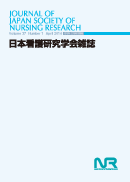All issues

Volume 7 (1984)
- Issue 4 Pages 4_7-
- Issue 3 Pages 3_3-
- Issue 1 Pages 1_70-
Volume 7, Issue 1
Displaying 1-5 of 5 articles from this issue
- |<
- <
- 1
- >
- >|
-
- By Using Interview with Postoperative Patients -Hiroko Kaneda, Kimi Kimura, Chikako Yonaiyama, Kiyoshi Kawakami1984Volume 7Issue 1 Pages 1_70-1_74
Published: April 01, 1984
Released on J-STAGE: March 31, 2016
JOURNAL FREE ACCESSTo ease preoperative anxiety of a patient is very important in preoperative nursing. This study reports on how an interview with postoperative patients lessens the anxiety of preoperative patients. The effect of interview was examined by STAI Test. The results are as follows:
1. The effect of the interview on easing preoperative anxiety was not so great as to be significant, but about 50% of the patients said that their anxiety was eased after the interview.
2. The interview had a significant effect on the patients in high anxiety tension state (ATS).
3. For this interview to be effective, preoperative patients have to talk with postoperative patients for more than 30 minutes in good human relationship between them.View full abstractDownload PDF (388K) -
Fumiyo Misawa, Kimi Kimura, Chikako Yonaiyama, Ruriko Fujimaru, Matsur ...1984Volume 7Issue 1 Pages 1_75-1_80
Published: April 01, 1984
Released on J-STAGE: March 31, 2016
JOURNAL FREE ACCESSRecently, the patients with tracheostomy are becoming to increase for prevention of respiratory disorders. It is important problem that tracheostomy is kept in clean condition.
In this study, bacterial contamination of the suction tube and disinfection solutions used for the maintenance of suction tube were examined.
The examined results were as followed.
1. Bacterial contamination of the suction tube increased by prolongation of its using times.
2. The effect of disinfection of the solution were most effective in 0.05% Hibitane, next in 0.02% Hibitane gluconate and most weak in 0.02% Hibitane.
3. Increasing of organisms were restrained by constant changing of the solution in the following time, i.e. every 3 hours in 0.02% Hibitane, every 8 hours in 0.02% Hibitane gluconate and every 12 hours in 0.05% Hibitane.
4. In order to keep of the tube in sterile condition, 0.05% Hibitane might be changed in every 3 hours.View full abstractDownload PDF (408K) -
Kazuko Miyazaki, Yasuko Yamada, Yukiyo Koyama, Chizuko Tanaka, Asae So ...1984Volume 7Issue 1 Pages 1_81-1_95
Published: April 01, 1984
Released on J-STAGE: March 31, 2016
JOURNAL FREE ACCESSDownload PDF (1259K) -
Naomi Ohmachi, Kimie Nonami, Yumi Horie, Nobuichi Uchiwa1984Volume 7Issue 1 Pages 1_96-1_104
Published: April 01, 1984
Released on J-STAGE: March 31, 2016
JOURNAL FREE ACCESSIn order to study on the adequate management of soft contact lenses, especially on cleaning procedures, the author made a questionnaire about the state for soft contact lenses of 86 students, then attempted to isolate microorganism contaminating on their lenses' surface. And bacteriological experiments on germicidal activity and cleaning efficasy of commercial cleaner (Meni-clean) for soft contact lenses contaminated artificially by Staph. epidermidis were also carried out.
The results obtained were as follows:
1) In the questionnaire, the actual methods of cleaning and disinfection by boiling soft contact lenses, disinfection of the wearer's fingers, employment of Hydro-care (protein remover), exchange of storage solution in their container were investigated. Consequently, it was found that a few students followed the management exactly as shown in the guidance.
2) A bacteriological studies were made on the state of contamination of soft contact lenses of 31 students picked up at random from 86 wearers. As a result, Ps. aeruginosa, Staph. epidermidis, Gram positive cocci, Gram positive bacilli, Gram negative bacilli and Fungi were isolated in higher concentration from storage solution than the surface of soft contact lenses wearing at present.
3) Judging from the inhibition of growth rate and elongation of lag phase, it can be said that Meni-clean has bacteriocidal action for Staph. epidermidis, too.
4) A bacteriological experiment was made on cleaning efficasy of soft contact lenses by 9 kinds of cleaning methods. As a result, it was found that the best cleaning effect for soft cleaning solution: 1.0ml, the number of scrubbing: 30 times for one lense in each cleaning.
5) By and by, the daily management for soft contact lenses, especially the cleaning procedure tends to be neglected, and so it is important to check up on the daily management, whenever the periodic examination are carried out.View full abstractDownload PDF (808K) -
- Family Care for Aged Patient after Apoplexy -Etsuko Kataoka, Atsuo Matuoka1984Volume 7Issue 1 Pages 1_105-1_116
Published: April 01, 1984
Released on J-STAGE: March 31, 2016
JOURNAL FREE ACCESS33, aged patients after approplexie in Ichihara city were studied on the relations between A.D.L. recovery and situational factors of nursing help to their daily life.
In order to prevent them from falling into bedridden cases, we accepted necessity to find recovering target from early time according to their stages, under A.D.L. estimation, as well as to enlighten family member to encourage and look after patients. Further, nursing needs were stressed on giving them possible role in their family based on their preserved function of basic activity, and on expanding socialization of patients for elevation of recovering intention of them.View full abstractDownload PDF (889K)
- |<
- <
- 1
- >
- >|